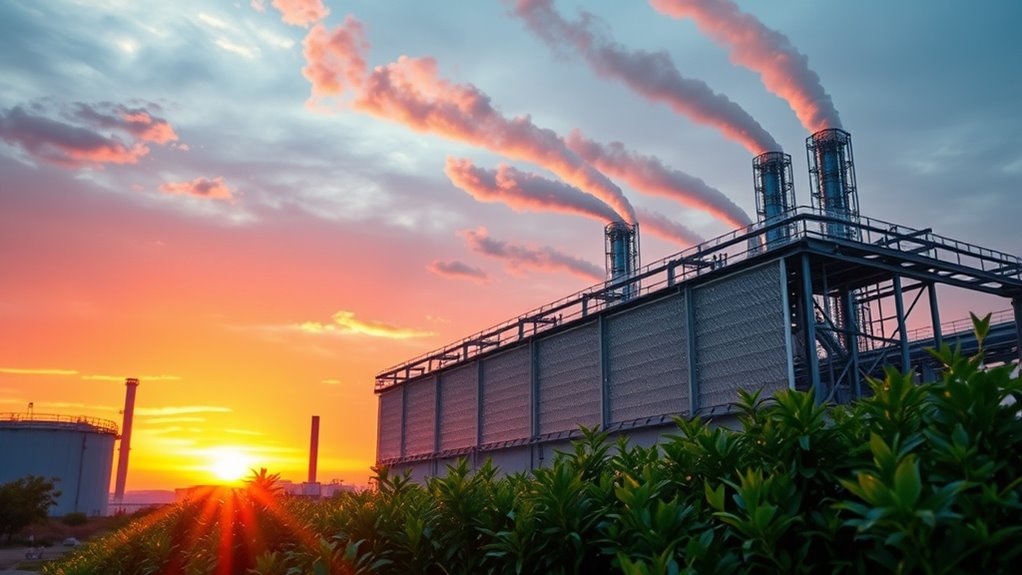Carbon capture technology, or CCS, is essential for combating climate change. It captures carbon dioxide (CO2) emissions from industries, and then transports and stores it safely underground. You'll find impressive methods like Direct Air Capture and post-combustion processes, which improve CO2 extraction efficiency. While CCS holds the promise of significant emissions reduction, it faces challenges like high costs and regulatory hurdles. Discover how it works and its impact on our climate goals as you explore further.
Key Takeaways
- Carbon Capture and Storage (CCS) captures CO2 emissions from industrial sources and involves capturing, transporting, and storing CO2 to combat climate change.
- Key CO2 capture technologies include Direct Air Capture (DAC), enhanced rock weathering, and post-combustion capture, each with unique methods and efficiencies.
- Effective CO2 storage solutions utilize geological formations, such as saline reservoirs and depleted oil fields, requiring careful monitoring for safety and stability.
- Economic impacts of carbon capture include potential job creation, improved public health, and capital costs ranging from $36 to $90 per ton of CO₂ captured.
- Policy frameworks and regulatory support are essential for overcoming financial barriers and encouraging the adoption of carbon capture technologies.
What Is Carbon Capture and Storage (CCS)?
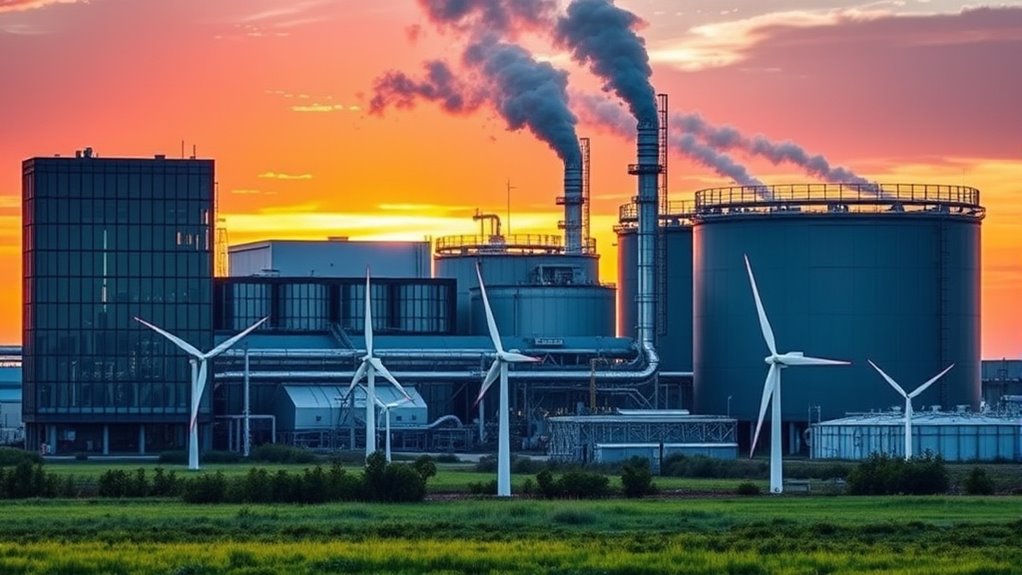
Carbon Capture and Storage (CCS) is a crucial technology designed to combat climate change by capturing carbon dioxide (CO2) emissions from industrial sources.
It involves three main steps: capturing CO2 from facilities like power plants, transporting it—often via pipelines—and storing it deep underground in geological formations. This process helps reduce greenhouse gas emissions, supporting global initiatives like the Paris Agreement. Additionally, the effectiveness of CCS can be enhanced by integrating it with renewable energy innovations, as advancements in technology can improve its efficiency and reduce costs. Hydrogen fuel cells are an example of renewable energy innovations that can further decrease overall emissions. Furthermore, the integration of CCS with geothermal energy can boost its effectiveness by utilizing stable underground temperatures for energy efficiency. The use of heat pumps can also contribute to reducing emissions by providing efficient heating solutions that complement CCS efforts.
While CCS has been in use for over 45 years, primarily in the oil and gas sector, high costs limit its widespread adoption. However, its potential economic benefits and role in enhancing oil recovery (EOR) make it an important solution for mitigating climate change. Proper maintenance of CCS systems is essential to ensure their effectiveness and longevity.
CCS, though costly, offers significant economic advantages and enhances oil recovery, making it vital for climate change mitigation.
CCS is essential in striving for a sustainable future.
Key Technologies Used in Carbon Capture

As the urgency of addressing climate change intensifies, understanding the key technologies used in carbon capture becomes essential.
You'll encounter various approaches, like Direct Air Capture (DAC), which extracts CO2 directly from the atmosphere. Power plants focus on capturing emissions before they're released, while Enhanced Rock Weathering speeds up natural processes to store CO2 in minerals. Environmental innovations play a crucial role in the development of these technologies, driving improvements in efficiency and effectiveness. Additionally, high refresh rates in projector technology parallel the need for advancements in carbon capture efficiency.
Membrane Gas Separation and Cryogenic Carbon Capture offer efficient methods for CO2 extraction. Other industrial applications include aqueous amine-based capture and post-combustion techniques.
Emerging technologies, such as biochar and metal-organic frameworks, promise scalability and reduced resource use. While energy efficiency and cost remain challenges, advancements in these technologies hold great potential for effectively addressing climate change. Additionally, diversification strategy in investment portfolios can help mitigate financial risks associated with transitioning to greener technologies.
Methods of CO2 Capture
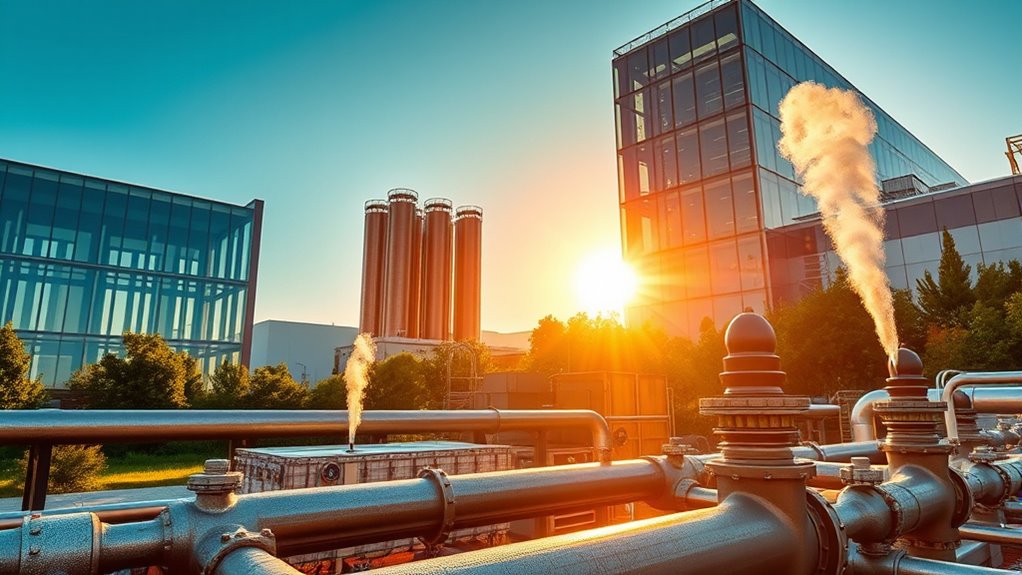
While various methods exist for capturing CO2, each technique offers unique advantages tailored to different sources and environments.
You can choose post-combustion capture, which uses chemical solvents to extract CO2 from flue gases after combustion. This method can be compared to Gold IRA options, which also seek to optimize financial returns through careful selection.
Alternatively, pre-combustion capture converts fuel to a hydrogen-rich mixture for easier separation. This approach aligns with advancements in renewable energy technologies, which enhance efficiency and sustainability. Additionally, implementing advance directives can guide decision-making processes in the context of environmental policy. Geothermal heat pumps, for instance, demonstrate energy efficiency by utilizing the Earth's stable temperature for heating and cooling.
Oxy-fuel combustion burns fuel with pure oxygen, enhancing capture efficiency.
For atmospheric capture, direct air capture (DAC) employs solid or liquid sorbents to extract CO2.
Biomass methods, like BECCS, generate energy while capturing emissions.
Emerging techniques, such as cryogenic carbon capture and chemical looping, show promise for future use.
With these options, you can find a suitable method to meet your carbon capture needs effectively. Additionally, integrating carbon capture with renewable energy sources can enhance overall energy efficiency and reduce greenhouse gas emissions.
Storage Solutions for Captured CO2
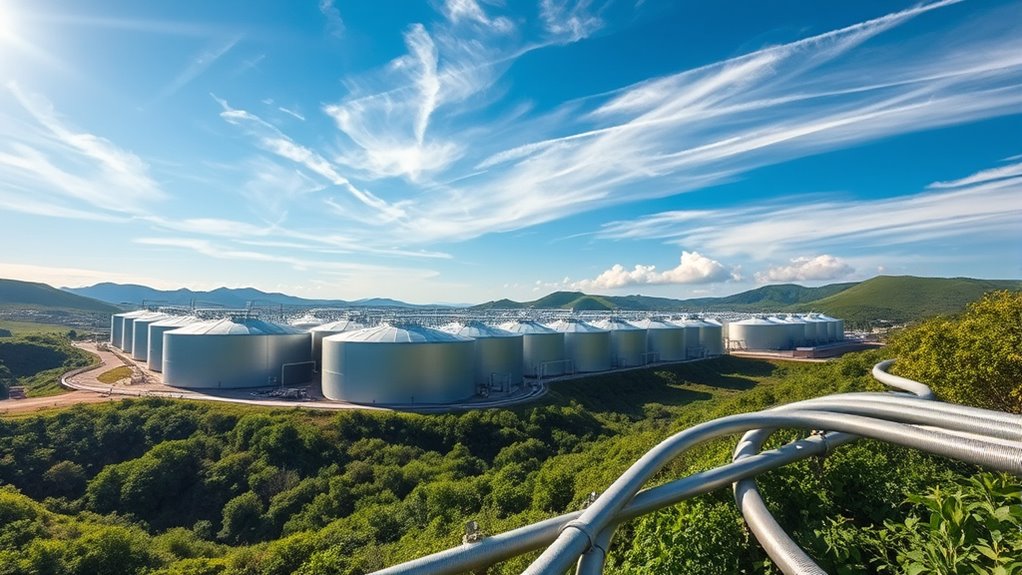
You can choose from several storage solutions, such as saline formations, depleted oil and gas reservoirs, unmineable coal seams, basalt formations, or organic-rich shales. Each option has unique characteristics, like needing to be at least 800 meters deep and having impermeable caprocks to prevent leakage. Additionally, the effectiveness of these storage methods can be enhanced by understanding advanced technology that improves monitoring and safety measures, including using inflation-protected annuities to secure financial investments in new energy ventures. You'll inject CO2 as a supercritical fluid, ensuring it remains stable within the geological formations. Regular monitoring is essential to assess geological stability and ensure safety, similar to how regular maintenance prolongs the lifespan of heat pumps. Furthermore, employing predictive analytics can help forecast potential risks associated with geological storage, enhancing overall safety and effectiveness. Understanding emotional dysregulation can also play a vital role in managing interactions during the storage process, ensuring all stakeholders remain aligned.
Economic Impact of Carbon Capture Technologies

Carbon capture technologies hold significant economic potential, impacting various sectors and creating new opportunities. While the capital costs can be high, ranging from $36 to $90 per ton of CO₂ captured, advancements in technology may drive those costs down over time. You'll find that these technologies not only spark job creation in the energy sector but also enhance energy security and improve public health by reducing air pollution. With effective risk management strategies in place, stakeholders can better navigate the economic landscape of carbon capture technologies. Additionally, smart shopping can be applied to the procurement of materials and services for carbon capture projects, further enhancing cost-effectiveness. As market demand shifts towards sustainable fashion, investment in carbon capture is booming. A retirement savings plan can also be an essential consideration for professionals entering the carbon capture sector, ensuring long-term financial stability. With government funding and incentives like the Inflation Reduction Act, investment in carbon capture is booming. As market expansion continues, integrating these technologies with existing infrastructure will likely boost their economic viability, paving the way for new industries and products that utilize captured CO₂. Additionally, mandatory mediation in divorce cases can serve as a model for collaborative approaches in resolving disputes related to carbon capture projects.
Policy and Regulatory Frameworks

The economic potential of carbon capture technologies is closely tied to the policy and regulatory frameworks that support their development and implementation.
Initiatives like the Carbon Capture Coalition's 2025 Blueprint and enhanced Section 45Q Tax Credits provide essential financial incentives. Understanding maintenance rights can also play a crucial role in ensuring that stakeholders are supported during the transition to greener technologies. Additionally, recognizing state tax implications can inform decisions on funding mechanisms for these projects. Moreover, leveraging tax advantages from similar frameworks can enhance the financial appeal of investing in these technologies. The integration of Natural Language Processing in customer interactions can also serve as a model for effective communication in promoting carbon capture initiatives.
Legislation such as the Infrastructure Investment and Jobs Act and the Inflation Reduction Act further fuels CCS projects.
Regulatory frameworks, including the Clean Air Act and state-level regulations, ensure safety and effective oversight. Permitting processes need improvement to facilitate deployment, while global cooperation encourages technology sharing and best practices. Additionally, understanding Roth vs. Traditional IRA strategies can provide insights into financing options for green technologies.
As you engage with these frameworks, you'll see how they shape the future of carbon capture, driving innovation and sustainability in your community and beyond.
Challenges Facing CCS Implementation
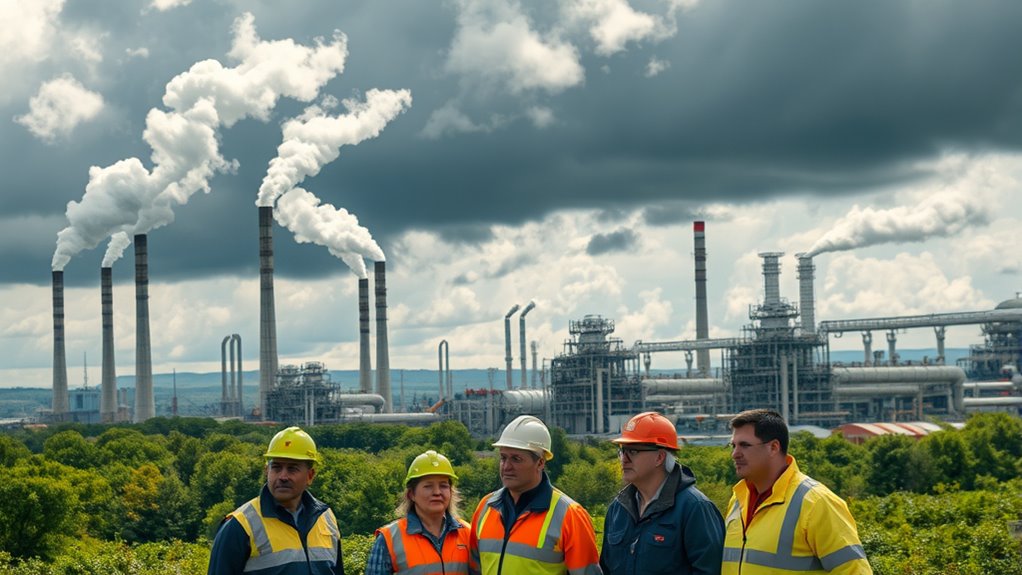
While significant advancements have been made in carbon capture technology, several challenges still hinder its widespread implementation. High costs associated with capture, transport, and storage facilities create substantial financial barriers. Without effective carbon pricing or robust financial incentives, you might find it hard to justify investing in CCS projects. Additionally, technical difficulties like capture efficiency and material integrity pose serious hurdles. Ensuring safe CO2 storage and preventing migration is crucial, while the energy penalty can reduce overall power generation efficiency. Moreover, the development of robust safety measures is essential to ensure the reliability of CCS technologies.
Furthermore, the lack of suitable geological formations and transportation infrastructure limits your options for CCS deployment. Addressing these challenges is essential for realizing the full potential of carbon capture technology and making it a viable solution for reducing emissions. Moreover, the increasing demand for AI Ethicist Jobs highlights the need for ethical considerations in technological advancements like CCS to foster public trust and accountability.
The Role of Carbon Utilization
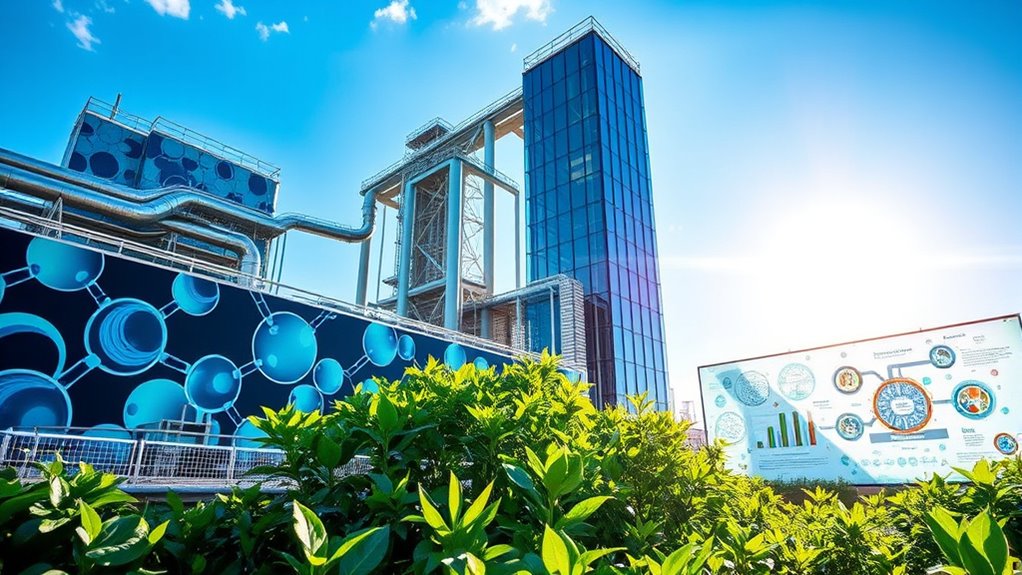
As industries grapple with the challenge of reducing emissions, carbon utilization (CU) emerges as a promising solution that transforms captured CO₂ into valuable products. CU allows you to use CO₂ as a feedstock for chemicals, fuels, and construction materials, creating economic opportunities while potentially lowering carbon capture technology costs.
However, the environmental impact hinges on whether CO₂ originates from the atmosphere or fossil fuels. The market for CO₂ utilization is growing, but it's still small compared to the emissions reduction needed.
To make a real difference, you'll need to scale up CU across various industries, particularly in sectors like cement and steel, where emissions are hard to eliminate. Policy support will be essential to accelerate this adoption.
Future Innovations in Carbon Capture

Carbon utilization has laid the groundwork for innovative advancements in carbon capture technology, pushing the boundaries of how we can tackle emissions.
Direct Air Capture (DAC) and post-combustion methods are leading the way, allowing you to capture CO2 directly from the air or flue gases. New materials like advanced solvents and tailor-made sorbents improve efficiency while reducing costs.
Innovations in membrane technologies enhance CO2 separation capabilities. As you explore carbon storage, options like geological formations and carbon mineralization are gaining traction.
With economies of scale and innovative funding models, the CO2 capture market is set to grow significantly. These advancements promise a future where capturing and utilizing carbon becomes not only feasible but essential for a sustainable environment.
The Importance of Carbon Capture for Climate Goals

Achieving climate goals hinges significantly on effective carbon capture technologies, which play a critical role in reducing greenhouse gas emissions.
Carbon capture and storage (CCS) is essential for reaching net-zero targets by 2050, especially in hard-to-abate industries. By capturing over 90% of CO2 emitted from power plants, this technology can significantly lower greenhouse gas emissions.
Carbon capture and storage is vital for achieving 2050 net-zero targets, particularly in challenging industries.
The Intergovernmental Panel on Climate Change (IPCC) emphasizes CCS's importance in limiting global warming to 1.5°C. As the market expands, it's projected to grow at a compound annual rate of 6.2% through 2030.
However, overcoming investment challenges and enhancing policy support are crucial to scaling these technologies. Ultimately, your involvement in supporting carbon capture initiatives can significantly impact our climate goals.
Frequently Asked Questions
How Does Carbon Capture Affect Local Air Quality?
Carbon capture can significantly improve local air quality by reducing harmful emissions.
You'll see reductions in carbon dioxide by over 90%, and particulate matter can drop nearly 90% as well.
Sulfur dioxide emissions can be reduced by up to 99%, leading to cleaner air.
These improvements not only enhance public health but also extend the longevity of equipment in facilities.
What Are the Potential Risks of CO2 Storage?
When you consider the potential risks of CO2 storage, you'll find several significant concerns.
There's the possibility of leakage through faulty seals or geological issues, which can harm the environment.
You also need to be aware of operational challenges, like transportation risks and the integrity of pipelines.
Additionally, high CO2 concentrations can pose health hazards.
Addressing these risks requires careful site selection, monitoring, and robust emergency response plans to ensure safety.
Can Carbon Capture Be Used in Residential Settings?
Yes, carbon capture can be used in residential settings.
You can reduce emissions from your heating system significantly, save on heating bills, and even benefit economically by utilizing captured CO2 industrially.
With innovations making the technology more accessible and affordable, you'll find it easier to adopt.
As public awareness grows, you'll likely see more incentives and support for integrating these systems into your home, promoting a sustainable future.
What Materials Are Used in Chemical Solvents for Capture?
In chemical solvents for capture, you'll often encounter amine-based solvents like monoethanolamine (MEA), which effectively react with CO(_2).
However, newer formulations, such as amine-promoted buffer salts (APBS), offer enhanced durability and lower energy demands. These advanced solvents can last longer and reduce operational costs, making them more efficient.
You might also find water-lean and single-component solvents that simplify handling and boost capture rates, providing a more effective solution for CO(_2) removal.
How Is Captured CO2 Transported to Storage Sites?
When it comes to transporting captured CO2, pipelines are your best bet. They're efficient and have a solid safety record.
If you're dealing with smaller amounts, trucks or trains work well for shorter distances. For international transport, ships come into play.
Existing pipelines can often be repurposed, saving you money. Just remember, safety's crucial—strict standards ensure the CO2 remains in a supercritical state, minimizing risks during transit.
Conclusion
In understanding carbon capture technology, you recognize its potential to reduce emissions, you embrace its role in combating climate change, and you see its promise for a sustainable future. By investing in innovative solutions and overcoming challenges, you can drive the transition toward a cleaner world. As you move forward, remember that every step towards effective carbon capture not only protects the planet but also paves the way for economic growth and energy security.
